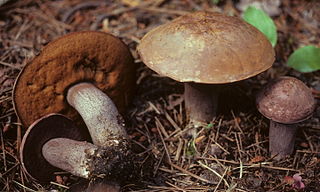
The eastern rosella is a rosella native to southeastern Australia, including Tasmania.

The genus Sorex includes many of the common shrews of Eurasia and North America, and contains at least 142 known species and subspecies. Members of this genus, known as long-tailed shrews, are the only members of the tribe Soricini of the subfamily Soricinae. They have 32 teeth.

Dryophytes eximius, commonly known as the mountain tree frog, is a species of frog in the family Hylidae endemic to Mexico. Its natural habitats are mesquite grasslands, scrub forests, and pine-oak forests. It is a widely distributed species that faces no major threats.

The green-tailed bristlebill is a species of songbird in the bulbul family, Pycnonotidae. It is found in West Africa from Sierra Leone to Ghana. Its natural habitat is tropical moist lowland forests. It is threatened by habitat loss. The green-tailed bristlebill was originally described in the genus Trichophorus. Formerly, some authorities considered the yellow-lored bristlebill as conspecific with the green-tailed bristlebill.

Anelosimus eximius is a species of social spider in the genus Anelosimus, native to the Lesser Antilles and the area from Panama to Argentina. Colonies can comprise several thousand individuals.

Mesosini is a tribe of longhorn beetles of the subfamily Lamiinae.

Planodes is a genus of longhorn beetles of the subfamily Lamiinae, containing the following species:

Neurankylus is an extinct genus of turtles in the family Baenidae that lived between 112 and 61 million years ago in Canada and the United States. It was originally placed within the monotypic family Neurankylidae, but it has since been placed in the Neurankylinae, alongside Trinitichelys. The type species, Neurankylus eximius, was described by Lawrence Lambe in 1902. The species N. lithographicus was discovered in the Milk River Formation (Canada), alongside the holotype of the pachycephalosaurid dinosaur Acrotholus audeti.

Sutorius eximius, commonly known as the lilac-brown bolete, is a species of fungus in the family Boletaceae. This bolete produces fruit bodies that are dark purple to chocolate brown in color with a smooth cap, a finely scaly stipe, and a reddish-brown spore print. The tiny pores on the cap underside are chocolate to violet brown. It is widely distributed, having been recorded on North America, South America, and Asia, where it grows in a mycorrhizal relationship with both coniferous and deciduous trees.
Planodes annamensis is a species of beetle in the family Cerambycidae. It was described by Stephan von Breuning in 1957.
Planodes gebeensis is a species of beetle in the family Cerambycidae. It was described by Stephan von Breuning in 1970.
Planodes johorensis is a species of beetle in the family Cerambycidae. It was described by Stephan von Breuning in 1936.
Planodes longemaculatus is a species of beetle in the family Cerambycidae. It was described by Stephan von Breuning in 1960, originally as Planodes longemaculata. It is known from the Philippines.
Planodes ambonensis is a species of beetle in the family Cerambycidae. It was described by Stephan von Breuning and Chûjô in 1965.
Planodes deterrens is a species of beetle in the family Cerambycidae. It was described by Francis Polkinghorne Pascoe in 1865. It is known from Malaysia and Borneo.
Planodes leporinus is a species of beetle in the family Cerambycidae. It was described by Francis Polkinghorne Pascoe in 1865. It is known from Borneo.
Planodes vicarius is a species of beetle in the family Cerambycidae. It was described by Francis Polkinghorne Pascoe in 1865.

Planodes denticornis is a species of beetle in the family Cerambycidae. It was described by Chevrolat in 1858.
Planodes quaternarius is a species of beetle in the family Cerambycidae. It was described by Newman in 1842. It is known from the Philippines.
Planodes is a genus of flowering plants belonging to the family Brassicaceae.








